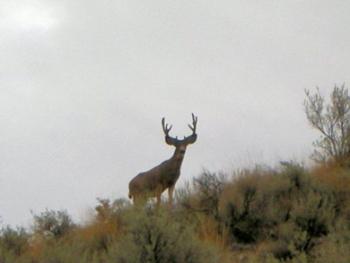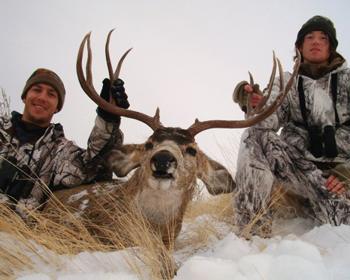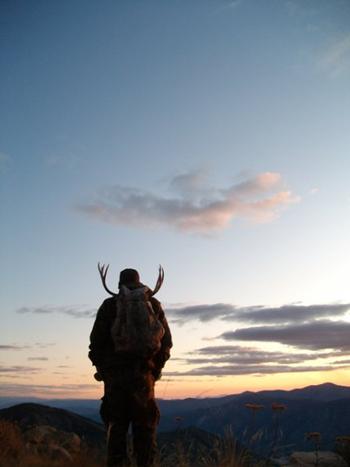5 Tips For Success In High Country Mule Deer Hunting
By Jason Verbeck
It’s getting to be that time of the year again. The weather is hot outside, there are blossoms on the apple trees, and the high country mountains are green, filling the bellies of mule deer bucks with the vital nutrients needed to grow dark, heavy and wide antlers that fill my dreams at night. However, it is also the time of the year that in my opinion is the most vital part of ensuring your success of harvesting a mature mule deer in the fall. With their red summer coats and sensitive velvet antlers, mule deer bucks stand out from miles away. By the beginning of July, their new horns will be large enough to estimate the potential they will have come fall.

Mule deer hunting to me is more than just a passion; it’d be better defined as an obsession. Many whitetail hunters believe mule deer are not as smart as whitetail. I can understand this if your goal is a three point, or maybe even a small four point. However, there is a reason that 80 percent of mule deer bucks that reach the age of five years old will die of old age. Simply put, they inhabit some country that most don’t dare approach. If you are up for the challenge, I’ve developed five key components that will set you up for a shot at success in the high country come fall, when most of the magnificent animals go back to being the “grey ghost” that they are commonly referred to by hunters.
I am sure you’ve read it in almost every magazine out there, but the greater the amount of time you can afford to scout, the greater your odds for success. One thing you may not read, however, is that it really does you little good to start scouting before the first few weeks of July. Anytime sooner than that, and the deer you see will more than likely still be working their way back up to their summer grounds. However, there are always things you can do to increase the odds of success, even from your computer at home.

Study
Before I head out in the field I spend a great deal of time looking at maps, talking to local biologists, readying their annual reports and studying Google Earth and other similar programs on my computer. I look over the areas I already know, and look back at spots from years past where I’ve documented seeing smaller bucks that might have had some time to grow. However, I also make it a point to search for two or three new areas that I believe have the potential to hold some bucks. The more time one spends scouting and hunting mule deer, the easier it becomes to recognize the areas that will hold them.
Personally, I look for three things: 1) Benches with good forage and cover. Ones which are at least halfway up a hill and hold escape routes in both directions tend to consistently hold animals. 2) Open basins, with finger ridges that hold timber. Bucks love to bed above their food sources in order to keep an eye out for danger from below. 3) Lastly, rim rock cliffs seem to be a magnet for mature bucks.

Keep in mind that, the biggest mule deer bucks aren’t always in the furthest, most remote areas you can find. When looking at maps, look for places others might overlook. Canyons that don’t hold any roads or hiking trails are definitely worth a closer look. I also make it a point to check out all areas of the high country that have burnt 2 to 3 years prior, as the area will have a more nutritional food source, and tend to be honey holes for mule deer.
Scout Properly
The most important piece of advice I have about scouting is to make sure to be set up at the highest point possible right at daylight to glass. Start by quickly glassing open areas for obvious signs of movement, After that, glass the eastern facing hillsides for the first 30 minutes of daylight as the sun rises, and then switch over to the western facing slopes, They will still have shadows and deer will stay feeding up to an hour longer. In the afternoons do the exact opposite of the morning, look over the eastern facing slopes first and then switch to the western facing ones for the last 30 minutes of daylight. Most of animals you see will be within the first half hour of daylight. It is very important to be set up and ready to glass before daylight. With the heat of summer, many bucks will stay bedded in the shade until dark. Most of these bucks will never be seen if you are looking up or straight across at them. I can’t stress enough the importance of being at the highest point and to make sure you arrive before daylight, and in the evenings stay until it is completely dark. You will see more mature bucks in the first five minutes and the last five minutes of daylight than you will the entire rest of the day.

Keep a Journal
I recommend keeping a journal of all your scouting trips. I even go so far as to make notes when looking at maps and topographical computer programs. It will also come in handy during the slow parts of the day to jot down quick ideas that come to your head, or sign you may see. There is never an unsuccessful scouting trip. Even though some will not be as successful as others, you will be in beautiful country and crossing off sections of the map and narrowing the search for one of those bucks, trophy animals that manage to be seen in the wintering grounds year after year. Though you will certainly remember every mature buck you come across, you’re not near as likely to remember a smaller buck. Bucks in the high country tend to use the same areas year after year and this may be a deer you’ll want to check out two or three years down the road.
Test Your Equipment
Scouting trips are also a great time to test out equipment. Make sure it is comfortable, fits properly and keep track of what gear you use and other items you wish you had, so you can add them the next time. Make sure to take all your equipment and test it out, before the hunt. Things that cause inconveniences in low land day hunts have the potential to be fatal on a wilderness hunt. I have seen far too many people show up for a week long wilderness hunt with a brand new pair of hunting boots that they are breaking out of the box for the first time.

Get in Shape
The last piece of advice, and probably the most crucial to you having an enjoyable hunt, is to get in shape. I suggest that anyone who plans on hunting the high country come fall start a workout program at least six weeks out. Personally, I start 10 to 12 weeks out. Cardio and weight training should be done at least three times a week, and it is very important to keep mixing your exercises up to ensure your muscles do not get used to the workouts. The last few weeks before the hunt, I recommend going on some hikes with a backpack equal in weight to what you will be packing into the backcountry. It isn’t so much the first couple days of the hunt that will bother you if you haven’t put in the work, but the fact that by the end of the hunt you’ll be tired and not be able to keep hunting hard all day, that could potentially blow your one chance at success. These high country mountains can be very tough on a man’s body and mind. So make sure to put in the work before the season starts. Crossfit.com’s workout of the day is a great place to get started if you are unsure about what kind of workout plan to get on. They have some great and challenging workouts. Make sure to eat healthy as well. Think about it as fuel for your body, and only give yourself the best fuel available. If anyone would like advice or help setting up a workout, or have questions in general, please feel free to shoot me an email at [email protected].
By Jason Verbeck
It’s getting to be that time of the year again. The weather is hot outside, there are blossoms on the apple trees, and the high country mountains are green, filling the bellies of mule deer bucks with the vital nutrients needed to grow dark, heavy and wide antlers that fill my dreams at night. However, it is also the time of the year that in my opinion is the most vital part of ensuring your success of harvesting a mature mule deer in the fall. With their red summer coats and sensitive velvet antlers, mule deer bucks stand out from miles away. By the beginning of July, their new horns will be large enough to estimate the potential they will have come fall.

Mule deer hunting to me is more than just a passion; it’d be better defined as an obsession. Many whitetail hunters believe mule deer are not as smart as whitetail. I can understand this if your goal is a three point, or maybe even a small four point. However, there is a reason that 80 percent of mule deer bucks that reach the age of five years old will die of old age. Simply put, they inhabit some country that most don’t dare approach. If you are up for the challenge, I’ve developed five key components that will set you up for a shot at success in the high country come fall, when most of the magnificent animals go back to being the “grey ghost” that they are commonly referred to by hunters.
I am sure you’ve read it in almost every magazine out there, but the greater the amount of time you can afford to scout, the greater your odds for success. One thing you may not read, however, is that it really does you little good to start scouting before the first few weeks of July. Anytime sooner than that, and the deer you see will more than likely still be working their way back up to their summer grounds. However, there are always things you can do to increase the odds of success, even from your computer at home.

Study
Before I head out in the field I spend a great deal of time looking at maps, talking to local biologists, readying their annual reports and studying Google Earth and other similar programs on my computer. I look over the areas I already know, and look back at spots from years past where I’ve documented seeing smaller bucks that might have had some time to grow. However, I also make it a point to search for two or three new areas that I believe have the potential to hold some bucks. The more time one spends scouting and hunting mule deer, the easier it becomes to recognize the areas that will hold them.
Personally, I look for three things: 1) Benches with good forage and cover. Ones which are at least halfway up a hill and hold escape routes in both directions tend to consistently hold animals. 2) Open basins, with finger ridges that hold timber. Bucks love to bed above their food sources in order to keep an eye out for danger from below. 3) Lastly, rim rock cliffs seem to be a magnet for mature bucks.

Keep in mind that, the biggest mule deer bucks aren’t always in the furthest, most remote areas you can find. When looking at maps, look for places others might overlook. Canyons that don’t hold any roads or hiking trails are definitely worth a closer look. I also make it a point to check out all areas of the high country that have burnt 2 to 3 years prior, as the area will have a more nutritional food source, and tend to be honey holes for mule deer.
Scout Properly
The most important piece of advice I have about scouting is to make sure to be set up at the highest point possible right at daylight to glass. Start by quickly glassing open areas for obvious signs of movement, After that, glass the eastern facing hillsides for the first 30 minutes of daylight as the sun rises, and then switch over to the western facing slopes, They will still have shadows and deer will stay feeding up to an hour longer. In the afternoons do the exact opposite of the morning, look over the eastern facing slopes first and then switch to the western facing ones for the last 30 minutes of daylight. Most of animals you see will be within the first half hour of daylight. It is very important to be set up and ready to glass before daylight. With the heat of summer, many bucks will stay bedded in the shade until dark. Most of these bucks will never be seen if you are looking up or straight across at them. I can’t stress enough the importance of being at the highest point and to make sure you arrive before daylight, and in the evenings stay until it is completely dark. You will see more mature bucks in the first five minutes and the last five minutes of daylight than you will the entire rest of the day.

Keep a Journal
I recommend keeping a journal of all your scouting trips. I even go so far as to make notes when looking at maps and topographical computer programs. It will also come in handy during the slow parts of the day to jot down quick ideas that come to your head, or sign you may see. There is never an unsuccessful scouting trip. Even though some will not be as successful as others, you will be in beautiful country and crossing off sections of the map and narrowing the search for one of those bucks, trophy animals that manage to be seen in the wintering grounds year after year. Though you will certainly remember every mature buck you come across, you’re not near as likely to remember a smaller buck. Bucks in the high country tend to use the same areas year after year and this may be a deer you’ll want to check out two or three years down the road.
Test Your Equipment
Scouting trips are also a great time to test out equipment. Make sure it is comfortable, fits properly and keep track of what gear you use and other items you wish you had, so you can add them the next time. Make sure to take all your equipment and test it out, before the hunt. Things that cause inconveniences in low land day hunts have the potential to be fatal on a wilderness hunt. I have seen far too many people show up for a week long wilderness hunt with a brand new pair of hunting boots that they are breaking out of the box for the first time.

Get in Shape
The last piece of advice, and probably the most crucial to you having an enjoyable hunt, is to get in shape. I suggest that anyone who plans on hunting the high country come fall start a workout program at least six weeks out. Personally, I start 10 to 12 weeks out. Cardio and weight training should be done at least three times a week, and it is very important to keep mixing your exercises up to ensure your muscles do not get used to the workouts. The last few weeks before the hunt, I recommend going on some hikes with a backpack equal in weight to what you will be packing into the backcountry. It isn’t so much the first couple days of the hunt that will bother you if you haven’t put in the work, but the fact that by the end of the hunt you’ll be tired and not be able to keep hunting hard all day, that could potentially blow your one chance at success. These high country mountains can be very tough on a man’s body and mind. So make sure to put in the work before the season starts. Crossfit.com’s workout of the day is a great place to get started if you are unsure about what kind of workout plan to get on. They have some great and challenging workouts. Make sure to eat healthy as well. Think about it as fuel for your body, and only give yourself the best fuel available. If anyone would like advice or help setting up a workout, or have questions in general, please feel free to shoot me an email at [email protected].

